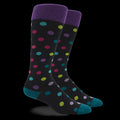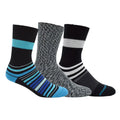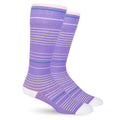Why Compression Socks are Your New Office Essential
Posted by HAYLIE SEGAL
Most of us, at one point or another, have felt the weariness of a long day at work, especially in jobs requiring extended periods of sitting or standing. But what if there was a simple solution to alleviate that leg fatigue? Enter: Compression socks.
The Underestimated Power of Compression Socks
Traditionally associated with medical conditions and athletes, compression socks have made their way into corporate cubicles and standing desks, all for good reason.
1. Improved Circulation: The primary benefit of compression socks is their ability to promote better blood flow. They apply pressure to your lower legs, helping to maintain blood flow and reduce discomfort and swelling. If you're someone who sits or stands for long hours, these socks can be a game-changer.
2. Reduced Leg Fatigue: Do your legs feel heavy and tired after a long workday? Compression socks help decrease the feeling of tired legs, allowing you to push through that end-of-day slump more comfortably.
3. Lower Risk of Deep Vein Thrombosis (DVT): For those with sedentary jobs, there's a potential risk for DVT, a blood clot in a deep vein, typically in the legs. While it's essential to take regular breaks and move around, wearing compression socks provides an added layer of prevention.
4. Enhanced Comfort for Those Always on Their Feet: For jobs that demand hours of standing—like retail, nursing, or teaching—compression socks provide relief by reducing the gravitational pull on blood flow, preventing the sensation of swollen, achy feet.
5. A Stylish Statement: Gone are the days when compression socks were bland and purely functional. Today's designs range from discreet to trendy, making it easy to incorporate them into your professional wardrobe.
Making the Switch
If you're considering adding compression socks to your work routine, start with a moderate compression level and consult a healthcare professional if you have existing medical conditions. Remember, the goal is comfort and better circulation, so ensure they fit well without feeling overly restrictive.
Conclusion
With the increasing acknowledgment of wellness in workplaces, it's no surprise that compression socks are gaining traction as an office essential. They're more than just a medical accessory; they're a proactive step toward better health, comfort, and productivity during your workday.
SHARE:




































